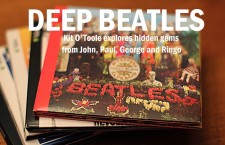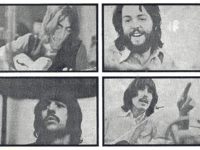A classic example of John Lennon’s love of wordplay, the Let It Be track “Dig a Pony” features some mysterious lyrics, raw Paul McCartney-Lennon harmonies, and crunching guitars.
Interestingly, the song divides fans. A sampling of comments on music blogs and YouTube reveals how fans either love or hate this track. Alan Pollack’s “Notes On” series refers to this division: “An admittedly non-scientific poll of my acquaintances reveals that some people just don’t like this song because of this sloppy, while over-the-top intensity,” he writes. Typical of Lennon’s harsh assessments of his work, he dismissed it as “another piece of garbage” in a 1980 interview.
Is “Dig A Pony” deserving of such scorn?
Lennon’s only major contribution to Let It Be, “Dig a Pony” was one of the earliest tracks recorded during the “Get Back” sessions. The version that was released, however, originates from the rooftop concert. Lennon first brought his new composition (originally titled “All I Want Is You”) to Twickenham Studios on January 2, 1969, when the Beatles were rehearsing material for a planned concert. As the group worked on arrangements on January 7 and 13, a film crew documented their every move for a planned film. The story is well known: The cameras exacerbated existing tensions, leading to George Harrison temporarily quitting the group. He eventually returned, but only after asking his bandmates to agree to certain terms, including recording at Apple Studios rather than the sterile movie set.
The Beatles resumed work on “Dig a Pony” on January 22, recording several versions (one of which surfaced on Anthology 3). Two days later they revisited the song, playing it several more times. This time they selected a take for the planned “Get Back” album. Still making adjustments on January 28, they ran through it yet again in preparation for the planned concert.
Finally, “Dig a Pony” made its public debut on January 30; after a brief rehearsal and a false start, the Beatles performed the entire song live. As McCartney stated in Anthology, “We decided to go through all the stuff we’d been rehearsing and record it. If we got a good take on it then that would be the recording; if not, we’d use one of the earlier takes that we’d done downstairs in the basement.” Originally produced by George Martin, an edited, Phil Spector-produced version would ultimately appear on Let It Be a year later.
Interestingly, Spector chose to edit out the repeated “All I want is you” phrase at the beginning and end of the track; Harrison sang backup on those sections of this rendition of “Dig a Pony.” Yet another version exists: on Let It Be … Naked, an edit of the rooftop performance and another version recorded on a different date is included. Billy Preston’s gospel-tinged piano can be heard more clearly in the Naked version as well.
The ambiguous lyrics challenge the listener, an intentional move on Lennon’s part. Asked to explain “Dig a Pony” in a 1972 interview, Lennon responded “I was just having fun with words. It was literally a nonsense song. You just take words and you stick them together, and you see if they have any meaning. Some of them do and some of them don’t.” Clearly, he wanted fans to decipher the words. As the Beatles Bible points out, some clearer references exist — such as “pick a moondog” (a possible nod to a previous band moniker for the Beatles, “Johnny and the Moondogs”) and “I roll a stoney” (a reference to pals the Rolling Stones?).
The lineup included Lennon on lead vocals and rhythm guitar; McCartney on harmony vocals and bass; Harrison on additional harmony vocals and lead guitar; Ringo Starr on drums; and Preston on keyboards. Preston’s tasteful but passionate piano perfectly complements the deep guitars and bass, while Starr’s drumming is understated but effective. The harmonies emphasize key lines, particularly the climactic “all I want is you” lyric.
Pollack discusses how Lennon assumes two voices in “Dig A Pony”; he labels them the “Exhorting Prophet” and the “Love Obsessed Screamer.” These simplistic categorizations beg for an alternative reading, namely a sequel to “Nowhere Man.” Lennon mocks someone who claims to possess rare knowledge. He calmly sings the lyrics, communicating seemingly philosophical statements.
Unlike “The Word” or “All You Need Is Love,” however, these words mean nothing. “I dig a pony; well, you can celebrate anything you want,” he begins, soon followed by head-scratching lines like “you can syndicate any boat you row.” The verse “you can imitate anyone you know” may be another clue that the narrator is wearing a mask, spouting rhetoric he may have heard someone else say. Yet, as Lennon discussed in later interviews, the words are largely nonsense.
The only time his voice rises in passion is when he yells “All I want is you — everything has got to be just like you want it to, because …” In 1969 he and Yoko Ono were in the early days of their romance, with love consuming the singer/songwriter. He further explored the theme in another Let It Be-era track, “Don’t Let Me Down,” as well as Abbey Road’s “I Want You (She’s So Heavy).”
While the “Love Obsessed Screamer” label may be true, another persona emerges. His raspy voice, increasing in volume and intensity, rises above his previously inhibited delivery only during these lines. Unlike the pseudo-philosophy spewed forth in previous lyrics, only the simple line “All I want is you” holds truth and power for the narrator. For him, his love for Ono supersedes everything else, rendering other words meaningless.
The next line, “Everything has got to be just like you want it to,” begins in the same unbridled way before the music briefly drops out. Lennon and McCartney then harmonize on the word “because,” signaling a change in direction and tone. From that moment, Lennon resumes his false philosopher pose, only breaking through when discussing love and lust. In other words, he fluctuates between the “Nowhere Man” and a wiser, more emotional, and less inhibited John Lennon.
“Dig a Pony” may seem unpolished in contrast to Abbey Road album tracks, thus has been dismissed as a throwaway. Yet the lyrics contain complexity beneath the surface, and the rumbling guitars, gospel-tinged piano, skilled drumming, and tight harmonies elevate the song from Let It Be curiosity to a prime example of Lennon’s sophisticated wordplay.
- The Rescued Early Paul McCartney Song That Completed ‘Beatles For Sale’ - December 4, 2024
- A Rare Beatles Cover Proves John Lennon Was Wrong About His Voice - November 26, 2024
- How John Lennon Came Roaring Back on the Beatles’ White Album - November 22, 2023




Nicely said, Kit. Both Lennon and McCartney’s “nonsense lyrics” inspired a number of young artists who would blossom into the world’s best songwriters like Jon Anderson of Yes. Not only the random structure of words but also their soundings would fire the imagination of listeners to this day, regardless if it made any sense at all.
Thank you, Paul! It’s interesting to me how people dismiss these lyrics.
Kit — I roll a stony was Lennon rolling a joint of weed. The Lyrics are about the generations do what you want — be who you want to be — do your own thing attitude– and make it public (Syndicate).